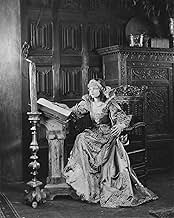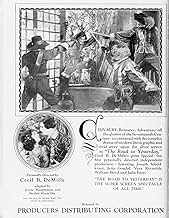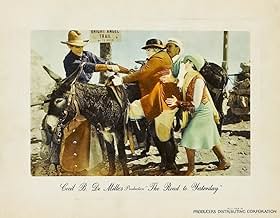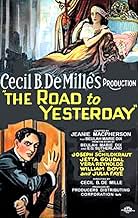A married couple discovers that their strained relationship is the result of unhappiness in their past lives.A married couple discovers that their strained relationship is the result of unhappiness in their past lives.A married couple discovers that their strained relationship is the result of unhappiness in their past lives.
Wilson Benge
- Kenneth's Butler
- (uncredited)
Robert Brower
- Elderly Party Guest
- (uncredited)
Charles Clary
- Doctor
- (uncredited)
Iron Eyes Cody
- Indian
- (uncredited)
Frank Coghlan Jr.
- Boy Scout
- (uncredited)
Walter Long
- Rowdy in Burning-at-the-Stake Scene
- (uncredited)
Chester Morris
- Party Guest
- (uncredited)
Sally Rand
- Party Guest
- (uncredited)
Storyline
Did you know
- TriviaThe production team was housed at the El Tovar Hotel at the Grand Canyon while working on location for this film.
- ConnectionsFeatured in Boom! Hollywood's Greatest Disaster Movies (2000)
Featured review
If Cecil B. DeMille was the high priest of hokum, his long-term screenwriter and mistress Jeanie MacPherson was its goddess. The Road to Yesterday is among the most gloriously nonsensical stories in the MacPherson canon, being a sweeping tale of scandalous love, divine intervention and not-so-divine reincarnation.
Despite the incompatibility of Christianity and "occult" beliefs, MacPherson had flirted with the subject of past lives before in Joan of Arc, Male and Female and a few others. This is her only screenplay to entirely revolve around the concept, and begins by reminding us that (apparently) we all have inexplicable dislikes or loves for other people, and that this is (obviously) all down to reincarnation. As the story wears on the daft ideas pile up, with one character inheriting an arm-ache from his past self, another just happening to own and casually use a medieval hunting knife, rather than donating it to a museum before it falls apart. The setting for the inevitable past-life flashback is (of course) Ye Olde Englande, complete with outlaws, wenches, witches burned at the stake etc. etc.
And yet director DeMille innocently films all this with amazing grace and visual flair. Of particular note here is the "Rembrandt" lighting and other tricks with shadows and stark framing. DeMille's goal with these techniques is not merely to show off; in spite of his reputation being all about scale and spectacle, DeMille always used cinematic technique to highlight characters, framing actors within dark backgrounds at moments of dramatic tension or picking out an individual in a crowd. Even in his mightiest epics DeMille never once lost sight of the human relations at the heart of the story, and this is always reflected in his visual style.
Also very much worthy of a mention here is DeMille's editor Anne Bauchens, who was the most prolific collaborator of his entire career. Unlike MacPherson and recurring character actress Julia Faye she was not one of the director's mistresses. She kept her standing in the DeMille stock company simply by being very good at what she did. Her work in the train wreck sequence, intercutting shots of the speeding locomotives with the fistfight between Boyd and Schildkraut, make it the most thrilling moment of the whole picture.
It is in these more outlandish collaborations that you can see how MacPherson and DeMille perfectly complement each other. Who else but DeMille was so good at making the ridiculous seem poetic? Yes, this story is absolute 24-carat hogwash, but DeMille handles it with such rhythm, such finesse and such grandeur, the chances are you won't care.
Despite the incompatibility of Christianity and "occult" beliefs, MacPherson had flirted with the subject of past lives before in Joan of Arc, Male and Female and a few others. This is her only screenplay to entirely revolve around the concept, and begins by reminding us that (apparently) we all have inexplicable dislikes or loves for other people, and that this is (obviously) all down to reincarnation. As the story wears on the daft ideas pile up, with one character inheriting an arm-ache from his past self, another just happening to own and casually use a medieval hunting knife, rather than donating it to a museum before it falls apart. The setting for the inevitable past-life flashback is (of course) Ye Olde Englande, complete with outlaws, wenches, witches burned at the stake etc. etc.
And yet director DeMille innocently films all this with amazing grace and visual flair. Of particular note here is the "Rembrandt" lighting and other tricks with shadows and stark framing. DeMille's goal with these techniques is not merely to show off; in spite of his reputation being all about scale and spectacle, DeMille always used cinematic technique to highlight characters, framing actors within dark backgrounds at moments of dramatic tension or picking out an individual in a crowd. Even in his mightiest epics DeMille never once lost sight of the human relations at the heart of the story, and this is always reflected in his visual style.
Also very much worthy of a mention here is DeMille's editor Anne Bauchens, who was the most prolific collaborator of his entire career. Unlike MacPherson and recurring character actress Julia Faye she was not one of the director's mistresses. She kept her standing in the DeMille stock company simply by being very good at what she did. Her work in the train wreck sequence, intercutting shots of the speeding locomotives with the fistfight between Boyd and Schildkraut, make it the most thrilling moment of the whole picture.
It is in these more outlandish collaborations that you can see how MacPherson and DeMille perfectly complement each other. Who else but DeMille was so good at making the ridiculous seem poetic? Yes, this story is absolute 24-carat hogwash, but DeMille handles it with such rhythm, such finesse and such grandeur, the chances are you won't care.
Details
Box office
- Budget
- $477,480 (estimated)
- Runtime1 hour 47 minutes
- Color
- Sound mix
- Aspect ratio
- 1.33 : 1
Contribute to this page
Suggest an edit or add missing content

Top Gap
By what name was The Road to Yesterday (1925) officially released in Canada in English?
Answer




























